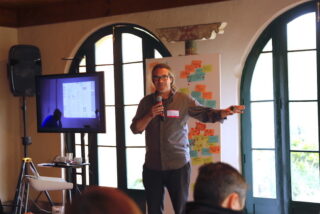This post is part 1 of a series.
At the start of the summer, we published a reading list for Internet-era CTOs. A lot of my work at Public Digital is about helping our clients understand what an internet-era CTO is, what skills and experience they should have, and how to hire one. I decided to write down some of the essentials, which we’re going to publish over the next few weeks as a series of blog posts.

Internet-era organisations need to be in control of their own technology destinies.
Everyone in a leadership position needs to have a sense of what should be easy and what should be hard. No-one should automatically switch off when technology becomes part of the conversation. But you also need strong technology leaders who can make sure the whole organisation is good at technology.
These are not just people who lead siloed functions. They understand the organisation’s purpose and direction and contribute to shaping both, but in that context they also make sure that technology can help move the organisation forward, rather than hold it back as is too often the case.
Their job is to create an environment where Internet-era ways of working are possible and sustainable, to make sure that’s done efficiently, and to make sure the organisation keeps building its technology awareness and skills. That’s particularly hard to do. They will need to manage the existing IT, keeping things running while simplifying them.
Three big things to do
It’s likely that this person will have three big things to do:
- get everything under control
- create the environment to demonstrate a new way of delivering
- continually seek out and bring to the table new ideas and opportunities
They will take the lead on big parts of this list, but they won’t do any of it on their own. Solving technology problems usually means changing how you build teams, what your supply chain looks like, how services are designed, and how organisations are structured.
An internet-era CTO will be able to identify what good looks like, where to start, and whose help will be needed along the way.
They’ll own their biases
Internet-era technology leaders will have a bias for internet-era technologies and ways of working. They usually have scars earned from trying to work from closed, proprietary technologies and large, inflexible systems.
Like Mark Schwartz, who was the technology leader at the US Citizenship and Immigration Service, they know that “risk is lack of agility,” and that you need to optimise for being able to change your technology quickly and effectively.
They’ll lean toward open source tools with strong communities, and do the hard work to help their organisations get comfortable with that (as Anna Shipman, now of the Financial Times, did in the UK government). They will understand the clear division of responsibilities that comes when you adopt good cloud tools. And their focus will be on users above all else, like the technical directors at the UK’s National Cyber Security Centre who often repeat their mantra that “user experience should be fantastic – security should be good enough.”
Most importantly, they’ll know that change is constant and will spend time preparing for it. That means drawing on techniques like Wardley mapping to understand how tools and techniques are moving from novelties to commodities. It also means investing in building curious, learning teams who will understand all this together, and investing in architectures that evolve as Rebecca Parsons of Thoughtworks has often discussed.
The unit of delivery is the team
A new technology leader won’t be able to do all this without help from their peers. The rest of the leadership team need to work together to create an environment where they can succeed.
That means being ready to clarify your outcomes, and work in partnership to achieve them. Even if that means re-allocating budgets to achieve results. Lack of shared outcomes, and power plays over budgets will undermine new leaders on day one.
Most new leaders come in to an overflowing pile of work to do. It can take months to find out what really needs to be done, and it’s not uncommon to never find your way out. To help a new technology leader be successful you need to be ready to prioritise, sometimes ruthlessly. Chances are your organisation has a lot to do, but you need to let this person help you find the right priorities. That may mean stopping work in progress, or even letting fires rage on out-of-control projects while you shore up the foundations, consolidate your capability and reset how you work.
Too many organisations are mired not just in old technology, but in old contracts and vendor relationships. Unless you’re willing to do the hard work to change that, this new hire won’t have any room to manoeuvre. Your whole leadership team needs to be ready to let go of any expectations around sunk costs and sweating assets, and to work together to increase your agility.
2 thoughts on Why hire an internet-era CTO? What will they actually do?
Year note, 2018 – Public DigitalDecember 19, 2018
[…] We also published blog posts on internet-era ways of working, government as a platform, and an ongoing series for Chief Technology Officers. […]
How to hire an internet-era CTO – Public DigitalOctober 17, 2018
[…] (This is part 2 of a series. If you haven’t seen it already, start with part 1: Why hire an Internet-era CTO?) […]